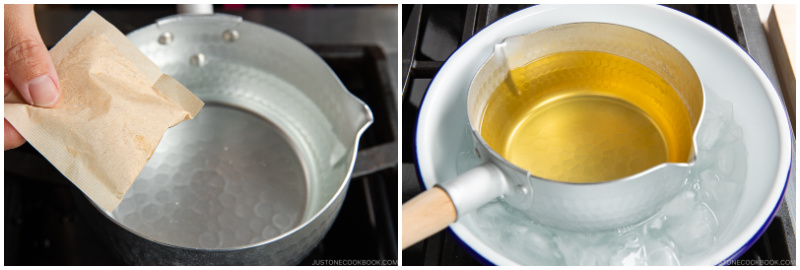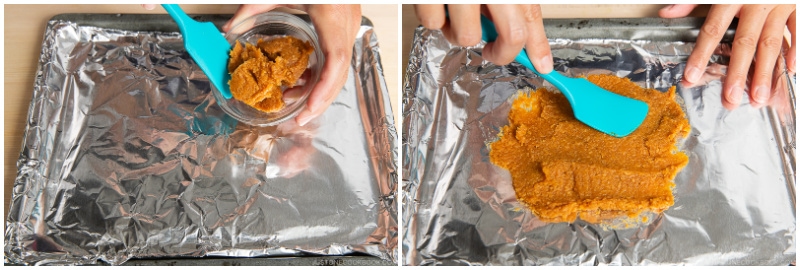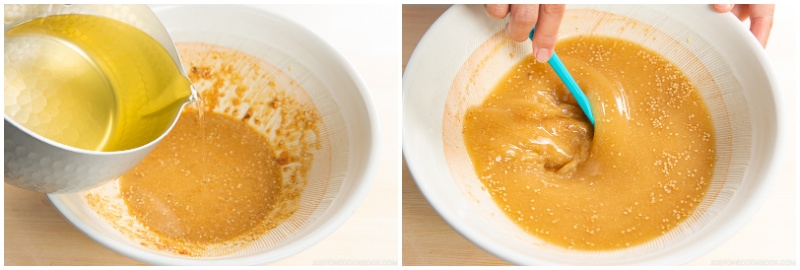Known as Hiyajiru in Japan, this cold miso soup is all that you need to nourish your body on hot summer days! It’s deeply flavorful and includes seasonal vegetables and grilled protein of your choice, making it one of the best cold soups to enjoy. Ready in 15 minutes! {Vegan Adaptable}

Living in the year-round dry and temperate San Francisco weather, I sometimes forget how hot the summer weather can be in most parts of the world. This past week, however, I was reminded of the true Japanese summer as my family spent a week on the East Coast where it gets uncomfortably hot and humid. I suddenly found myself craving for some cold soup, specifically this special bowl of Cold Miso Soup called Hiyajiru (冷や汁).
It’s special because it’s rare that a bowl of cold soup can be both satisfyingly filling and light. But that’s the magic of hiyajiru. Let’s find out more!
Table of Contents

Why You Should Make This Cold Miso Soup
- Cold, refreshing, and nutritious! Not only is it a tasty soup, it is also chock full of vitamins, probiotic, fiber, Omega-3 fatty acid, protein and all. What a terrific wholesome meal to enjoy on hot summer days!
- Super easy to make as the soup repurposes your leftovers.
- Versatile with different add-on toppings!
- Vegan-friendly. Use Kombu Dashi and add pan-fried tofu or mushrooms as toppings!
What is Hiyajiru – A Regional Dish from Miyazaki, Japan
Hiyajiru (冷や汁) is chilled miso-flavored soup featuring summer ingredients such as cucumber, shiso (perilla leaf), and myoga ginger as well as grilled fish and tofu for proteins. Typically served with or served over steamed white rice, this cold soup is a perfect dish to restore your appetite and overcome the summer heat in Japan.
This dish has been around in Miyazaki prefecture in southwestern Japan since the late 12th century (Kamakura era). It was eaten by farmers working in the fields or eaten as a combat ration at the battle front.
Since it can be made very quickly by using leftover grilled fish or tofu, we often enjoy cold miso soup as a simple, no-frills meal in the heat of summer.

How to Cook Cold Miso Soup
Ingredients You’ll Need
- Dashi (Japanese soup stock) – Use Kombu Dashi for vegan/vegetarian. In this recipe, I use a dashi packet method to make a quick dashi. Read here to learn more about this Japanese soup stock.
- Miso (Japanese fermented soybean paste) – It can be any type of miso. Feel free to experiment and use a variety of miso as each one yields a different flavor profile for your hiyajiru.
- White sesame seeds
- Tofu – Cold tofu (yes, we can eat it out of the package) or Teriyaki Tofu
- Japanese-style grilled salmon – Salted Salmon, Teriyaki Salmon, and Miso Salmon.
- Cucumber – Use Japanese or Persian cucumber that has less seeds in the middle. If you can’t find it, use English cucumber but remove the seeds with a spoon after cutting in half vertically. I do not recommend using American cucumber.
- Shiso (Perilla leaves) – Shiso is a quintessential Japanese herb. For substitute, you can use green onions.
Substitutes: Think of this cold soup as a blank canvas. If you don’t like salmon, try other types of grilled fish or shrimp. You can reach for any leftover grilled chicken or any cooked protein too.
Overview: Cooking Steps
- Make dashi (Japanese soup stock) and chill it until ready to serve.
- Toast the miso in the toaster oven until slightly charred. Remove from the oven and let cool completely.
- Grind the sesame seeds and add the toasted miso. Gradually add chilled dashi to the sesame miso mixture and make sure there are no lumps.
- Add sliced cucumber, tofu cubes, grilled salmon, shiso leaves, and additional white sesame seeds.
- Serve it with or over the steamed rice.

3 Tips to Make Delicious Cold Miso Soup
- Toast the miso until lightly charred. This gives a nice layer of flavors to the miso. If you don’t have time, you can skip this step, but do give it a try at least once. You’d notice how much flavor toasted miso brings to the overall taste.
- Salt the cucumber to withdraw the moisture. This helps the cucumber to become crisp, similar to pickled cucumber.
- Mix the miso and sesame seeds with a small portion of the dashi. The goal is to dissolve the miso paste completely before adding more liquid to the bowl. It’s very hard to dissolve a chunk of paste with a large volume of liquid.
What to Serve with Cold Miso Soup
This cold miso soup itself is very well-balanced and makes a fine meal to enjoy with a bowl of steamed rice. For a more elaborate meal, you can always serve it with one or two more side dishes such as:
- Blistered Shishito Peppers with Ginger Soy Sauce
- Edamame (Perfectly Cooked and Seasoned)
- Miso Glazed Eggplant
- Yakitori Style Grilled Vegetables
- Okra Ohitashi (Japanese Okra Salad)

Wish to learn more about Japanese cooking? Sign up for our free newsletter to receive cooking tips & recipe updates! And stay in touch with me on Facebook, Pinterest, YouTube, and Instagram.

Cold Miso Soup (Hiyajiru)
Video
Ingredients
For the Dashi (Japanese Soup Stock)
- 2½ cups water
- 1 dashi packet (you can use dashi powder, but I highly recommend this brand of dashi packet; you can also make dashi from scratch or Vegan Dashi)
For the Soup Seasonings
- 4 Tbsp miso (I usually toast 1 extra tablespoon just in case I need to add more; possibly you may not need to use the extra portion)
- 2 Tbsp toasted white sesame seeds
For the Soup Ingredients
- 4 oz Japanese or Persian cucumber (if you use an English cucumber, cut in half lengthwise and remove the seeds with a spoon; do not use an American cucumber)
- ¼ tsp Diamond Crystal kosher salt
- 10 shiso leaves (perilla/ooba) (or use chopped green onions)
- 1 fillet cooked salmon (I usually add simple grilled fish such as Salted Salmon, Teriyaki Salmon, Miso Salmon, and Grilled Mackerel (Saba Shioyaki)
- 7 oz medium-firm tofu (momen dofu)
Instructions
- Gather all the ingredients.

To Make the Dashi (Japanese Soup Stock)
- First, make the dashi. Add 2½ cups water and 1 dashi packet to a saucepan, and bring it to a simmer on medium heat. Let it steep for 2–3 minutes on medium-low heat. Remove from the heat and let the saucepan cool over a bowl of iced water. For vegans/vegetarians, you can make Kombu Dashi.

To Prepare the Sesame and Miso
- On a baking sheet lined with aluminum foil, spread 4 Tbsp miso.

- Toast the miso in a toaster oven or the oven broiler for several minutes (8 minutes for my toaster oven) until the surface is slightly charred. Remove from the toaster/broiler and let cool.

- Add 2 Tbsp toasted white sesame seeds to a Japanese mortar, reserving some sesame seeds for garnish later. Using a Japanese wooden pestle, grind the sesame seeds.

- Add the toasted miso to the mortar and set it aside (we‘ll mix them with the chilled dashi later).

To Prepare the Ingredients
- Peel the skin of 4 oz Japanese or Persian cucumber in stripes by alternating peeled and unpeeled strips down the length of the cucumber. Then, thinly slice it.

- Transfer the cucumber slices to a tray or plate and sprinkle with ¼ tsp Diamond Crystal kosher salt. Gently rub the cucumber slices with your hands. The salt will draw out the moisture from the cucumber slices and make them crisp. Set aside for 5 minutes.

- Remove the stems of 10 shiso leaves (perilla/ooba) and roll them up. Cut them into julienned strips. Set aside.

- Break up 1 fillet cooked salmon into smaller pieces. Squeeze the cucumber slices to remove the moisture. Keep all the ingredients on a tray or plate.

To Assemble and Serve the Soup
- When the dashi is cold and the toasted miso is no longer hot, pour a small portion of the dashi into the mortar. Using a silicone spatula or spoon, stir well to dissolve the miso in the stock.

- Once the miso is dissolved completely, add the rest of the dashi and mix it all together.

- Cube 7 oz medium-firm tofu (momen dofu) (the Japanese usually cut tofu while holding it on their palm, but you can cut it into ½-inch (1.3 cm) cubes on a cutting board first). Add the cubed tofu to the mortar. Then, add the salmon pieces.

- Add the cucumber and shiso leaves. You can chill the soup longer in the refrigerator or you can serve it immediately in individual bowls. Typically, Cold Miso Soup is served with steamed rice. Some enjoy it by pouring the soup over rice or vice versa.

To Store
- You can keep the leftovers in an airtight container for 2–3 days. You do not need to reheat. Enjoy it chilled.








Have made this a couple of times since first seeing this recipe last year, and it’s something that my partner and I keep returning to, especially on hot summer days! Perhaps quite unorthodox, but we love to add some cooked somen noodles to the hiyajiru directly to make it a full meal 🙂 thank you for sharing this recipe with us!
Hi, Sierra! Aww. We’re glad to hear you enjoyed Nami’s recipe!
The addition of somen noodles sounds delicious as well. 😊 Thank you for sharing your experiences with us.
Made this Cold Miso Soup — delicious and perfect for a hot & humid summer day.
Hello, LaVonne. Thank you so much for trying Nami’s recipe and providing such positive comments!
We are happy to hear that this chilled soup was ideal for the summer and that you liked it as much as we did!
Happy Cooking!
If I want to use homemade dashi instead of the packet, how much would I use? Would I just replace the water with the dashi?
Hi Benson! Thank you for trying Nami’s recipe!
Yes! Please replace the water amount with homemade dashi for this recipe. 😉
We hope you enjoy the Cold Miso Soup!
Looks delicious! Any substitute for the salmon, Persian cucumbers and shiso leaves? These are not accessible to me and the grocery stores in my area
Hi Loe! I mentioned the substitution information in the ingredient list on the recipe card. I also mentioned in the blog post that you can be creative and use leftover fish or meat as a topping and use available vegetables on top. I hope you enjoy the recipe!
I have had no luck finding shiso leaves in my area and unfortunately the seeds I planted this spring never sprouted. But I find the taste of shiso may be approximated by a combination of fresh basil leaves and a little mint. Maybe those are more easily sourced for you.
Perilla seeds have a very short viability and unpredictable germination, but once you have them in your ground they are a very Very persistent hardy annual. I have two colors in pots that I keep, and I’m always picking seedlings out of my yard. If you can get some seedlings and bring them to maturity, they will self-sow readily. Just keep your culture going by letting some plants go to seed and be prepared to put up with some weediness.